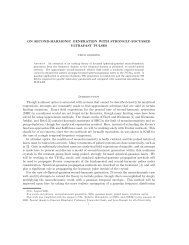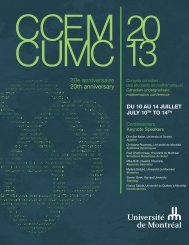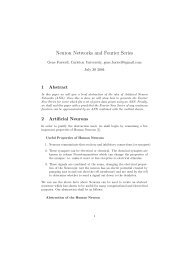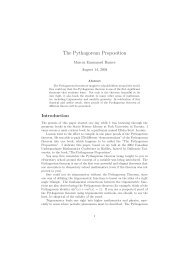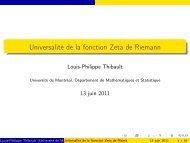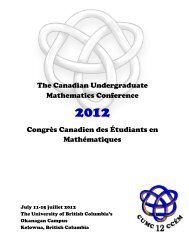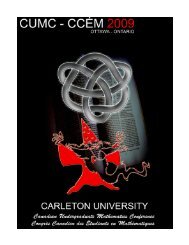booklet - CUMC - Canadian Mathematical Society
booklet - CUMC - Canadian Mathematical Society
booklet - CUMC - Canadian Mathematical Society
You also want an ePaper? Increase the reach of your titles
YUMPU automatically turns print PDFs into web optimized ePapers that Google loves.
SIMULATIONS MAGNÉTOHYDRODYNAMIQUES DU CYCLE DE L’ACTIVITÉ SOLAIREPAUL CHARBONNEAULe champ magnétique du soleil est le moteur et la source d’énergie de tous lesphénomènes définissant l’activité solaire. C’est pourquoi sa modélisation demeure lapierre angulaire des études des interactions soleil-terre, allant de la soi-disant météospatiale à l’influence possible de l’activité solaire sur le climat terrestre. Dans le cadre decette présentation j’offrirai d’abord un bref narratif historique de la découverte du cyclemagnétique, suivi d’un tout aussi bref survol des diverses manifestations de l’activitésolaire. Je décrirai ensuite le modèle mathématico-physique décrivant l’évolution duchamp magnétique solaire, sois la magnétohydrodynamique, et discuterai des diversesdifficultés mathématiques et physiques qu’il présente. Je terminerai en présentantquelques résultats de simulations numériques effectuées dans mon groupe de rechercheau département de physique, qui ont pour la première fois réussi à produire des inversionsde polarité ressemblant à celles observées sur le soleil.MCMC METHODS AND THE METROPOLIS-HASTINGS SAMPLERMYLÈNE BÉDARDIn this talk, we learn how MCMC methods were introduced in the literature. Wedetail the construction of the Metropolis-Hastings (MH) sampler, and expose the mainquestions of interest in this field. We discuss the tuning of Metropolis-Hastings algorithms,and present some results about the optimal scaling issue for an important classof Metropolis-Hastings samplers.PERMUTATIONS, CARD SHUFFLING AND REPRESENTATION THEORYFRANCO SALIOLAWe will give an overview of the mathematics involved in a recent project that grewfrom the desire to understand why a certain family of combinatorial matrices are pairwisecommutingand have only integer eigenvalues. We will explore connections with cardshuffling and with representation theory, and indicate how these can be used to studythe eigenvalues and eigenspaces of the matrices.KNOT THEORYSTEVEN SIVEKHow can you tell whether a circle in 3-dimensional space is knotted, and how canyou tell two such knots apart? I will give an introduction to knot theory, showing howa variety of both classical and modern ideas from topology, algebra, representationtheory, and differential geometry can be applied to these questions, and explainingsome interesting things that knots have to tell us about topology in return.14



